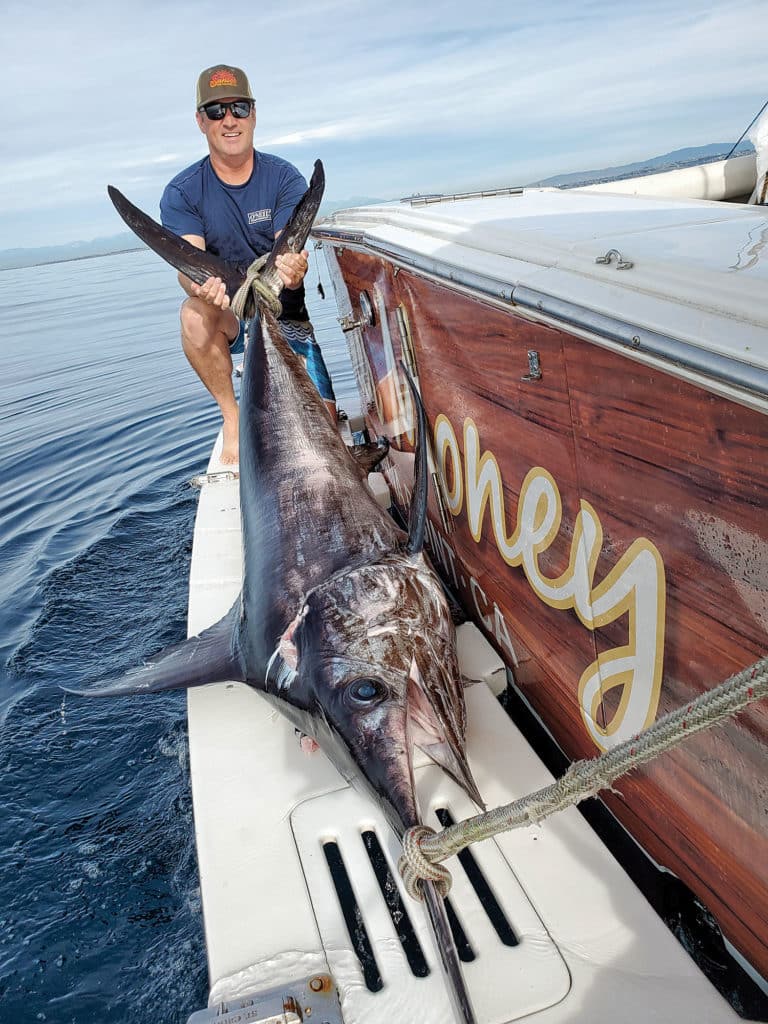
The unmistakable twitching of the rod tip alerted Joey Engel that a swordfish had found the rigged squid drifting some 1,100 feet below.
Suddenly, the rod sprung upward, an indication that the sword had inhaled the bait and was now rocketing toward the surface.
Engel wound furiously and came tight on the fish as it angled upward. Then the swordfish exploded at the surface, slashing the water to a froth like a windshield wiper gone berserk, before reversing course and diving, peeling line until it settled just below the thermocline. Engel applied steady pressure and slowly worked the fish back up for 45 minutes until it surrendered. Crewmembers gaffed and hauled the 150-pound fish aboard amid hoots and high-fives.
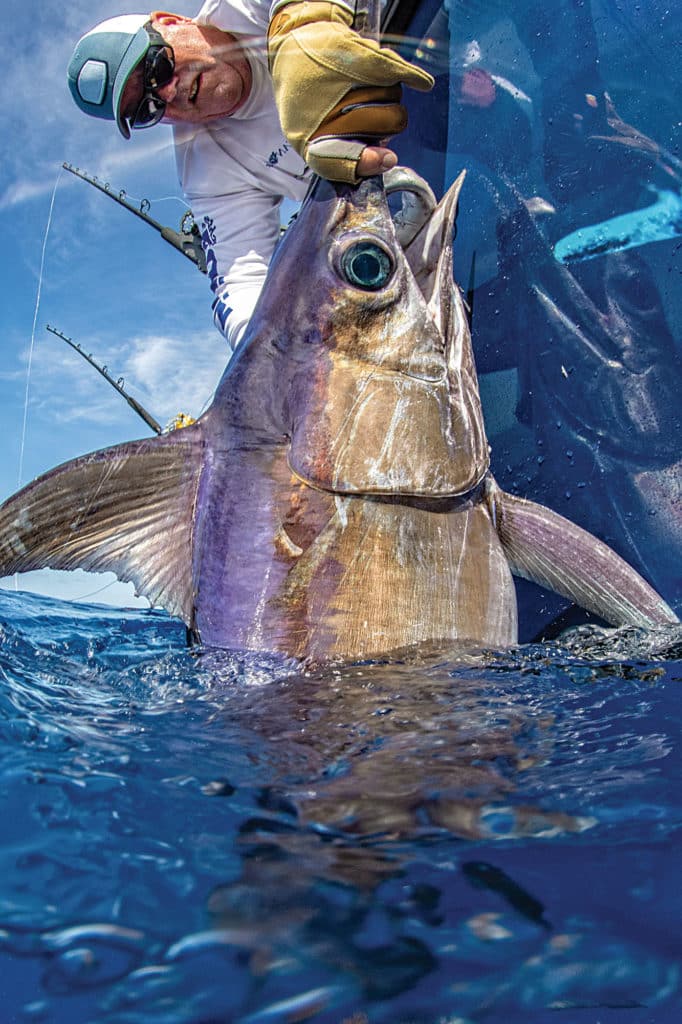
Burgeoning Fishery
Anglers on the East and Gulf coasts, having perfected daytime swordfish techniques, have enjoyed similar experiences for years. But Engel’s catch took place off the coast of Southern California, where deep-dropping for broadbills is a recent development. Just as significant, Engel’s catch took place less than 5 miles off Newport Harbor.
Right Conditions
Winding underwater canyons snake outward along the entire Southern California bight, resulting in nutrient-laden upwellings, attracting a host of life-forms, including deepwater squid and fish, prime forage for swordfish. Hueneme Canyon, Dume Canyon, Redondo Canyon, San Gabriel Canyon, Newport Canyon, Carlsbad Canyon and La Jolla Canyon all lie within a few miles of shore, putting daytime swordfishing within easy reach of boats as small as 18 to 20 feet.
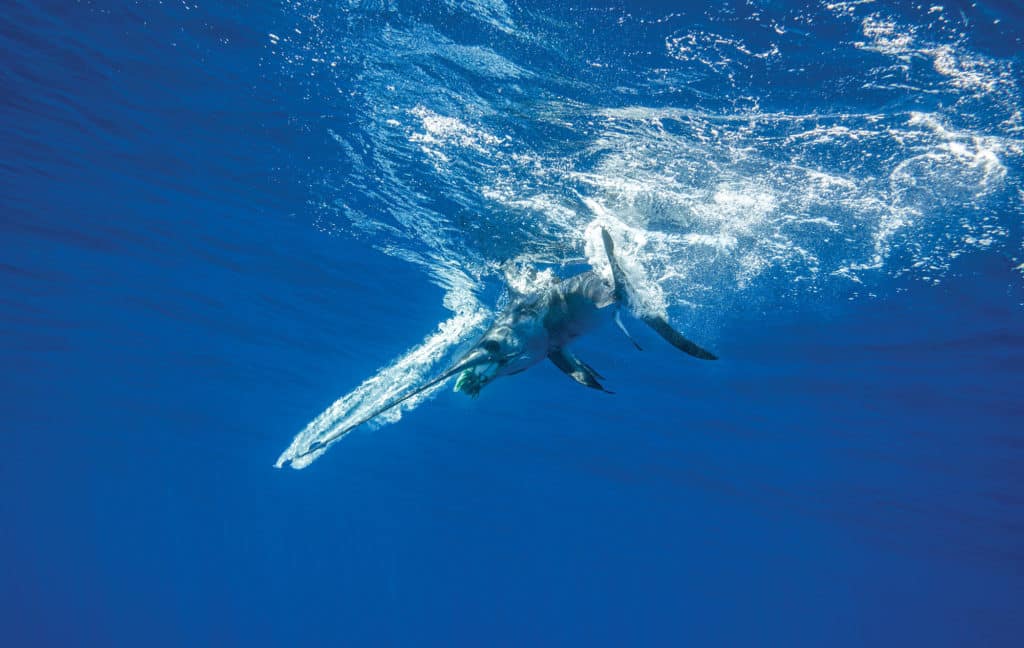
Early Clues
So, why have SoCal anglers only recently discovered the secrets to catching daytime swordfish? Well, it’s not for lack of experimenting. Commercial catches of swordfish with drift gill nets, longlines and harpoons have long served as strong indicators of an abundant seasonal population of swordfish. And for decades, intrigued anglers have applied the same daytime deep-drop techniques developed by East Coast and Gulf swordfish specialists to the Pacific waters off California, but found little success.
A turning point came a few years ago, when the California Department of Fish and Wildlife established an experimental deep-set buoy-gear fishery for swordfish to encourage a commercial fishery less indiscriminate than drift gill-netting. As commercial boats perfected the technique, anglers took note and smartly adapted the tactics for sport fishing.
In-Depth Savvy
One of those anglers was Engel, who had worked on a deep-set buoy-gear boat based in Dana Point Harbor. This experience gave him a leg up in the recreational quest, especially when it came to the most productive areas and depths to target swordfish.
“What the commercial guys taught us sport fishermen is that we were fishing way too deep,” Engel explains. “We also learned that the fish hunt higher in water column than we originally thought.”
Today, most anglers begin the search for swordfish off SoCal in depths of 1,400 to 2,000 feet, along sloping canyon walls, the edge of the continental shelf, or flanks of marine seamounts.
Engel also learned that swordfish tend to hunt above the bottom during the day. “We position baits from 800 to 1,100 feet below the surface,” he says.
To pinpoint the depth at which the bait is most abundant, Engel employs a powerful, low-frequency fish finder. “Look for the scattering of bait and other life, and then place your rigged baits so they drift through that zone,” he advises.
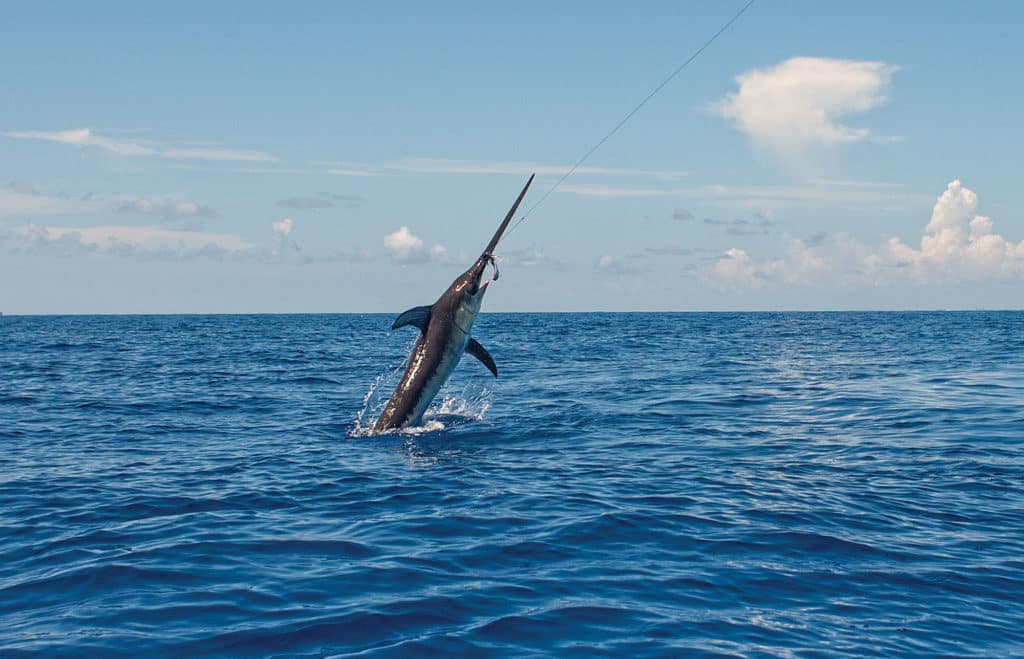
Stay Calm
Many anglers feel that free-drifting commercial gear presents the bait more naturally than a line attached to a boat because a boat drifts faster than a free-floating buoy, especially on a breezy day. But sport-fishing convention—as well as regulations—mandate deep-drop lines must be fished from the boat. For this reason, most daytime swordfish anglers like to fish in the calmest conditions.
“You try to keep the line as vertical as you can,” Engel says. “And that’s only possible in calm waters. Once the line starts to angle, you might as well quit fishing for swords.”
Currents on the West Coast are not as strong as in the Gulf Stream, so when breezes are light, keeping the line vertical is not too difficult.
Bait of Choice
Rigged squid, between 12 and 15 inches in length, represent the most popular bait among SoCal swordfish enthusiasts. Not only is squid one of a broadbill’s favorite foods, but it is also more resistant to the smaller fish and other squid that might decimate a less hardy rigged bait, such as rigged mackerel, bonito or mahi belly.
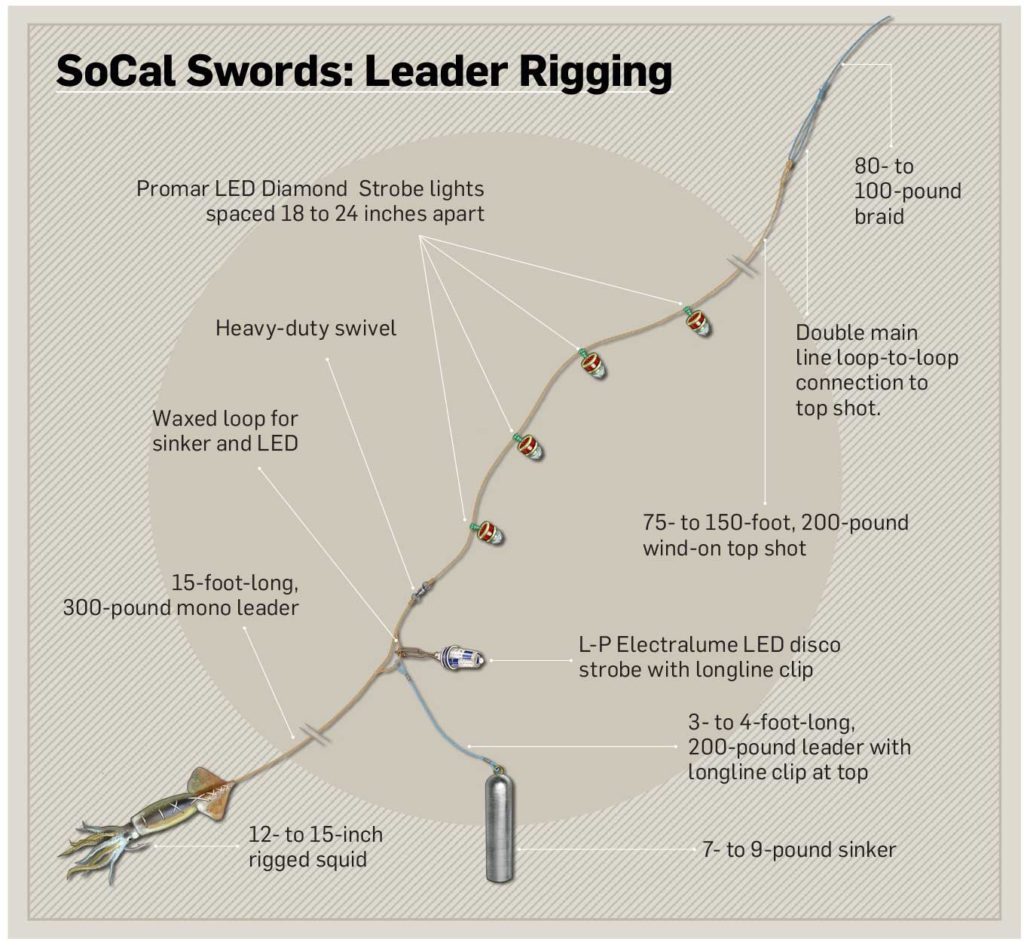
A growing number of daytime swordfish anglers, including Engel, rig their own squid using fresh squid purchased from local fish markets. Those new to the game often use pre-rigged squid, increasingly available at tackle shops. These come rigged with a single Mustad Ultra Point 11/0 3X-strong hook and a 15-foot, 300-pound-test mono leader.
Engel prefers to rig squid without a skirt. However, a number of anglers like to use a vinyl skirt over the squid to enhance the action and help fend off bait stealers. Preferences in color run from fluorescent green to red-and-black.
Rig for Depth
Electric reels, such as the Daiwa Seaborg 1200MJ and Shimano BeastMaster 9000A, see service because they allow anglers to easily retrieve heavily weighted baits, then disengage the motor and fight a hooked fish manually. The LED readouts on these reels display the amount of line sent out.
A fair number of anglers remain loyal to manual lever-drag, two-speed reels, such as a Penn International 50 Wide or a Shimano Tiagra 50 Wide, especially when fishing in tournaments that disallow electric-assist reels.
A useful accessory for retrieving deep baits with manual tackle, the Reel Crankie from Innovative Fishing Tackle connects to a reel handle and uses a cordless drill to wind line onto the reel. Additionally, the ErraMarine Kristal fishing line counter clamps to the rod between the reel and first guide.
Whichever tackle you choose, it is important to idle ahead and deploy the line slowly to prevent tangles in the terminal rig on the way down. Most anglers keep the rod in a holder when dropping the line, and also while drift-fishing.
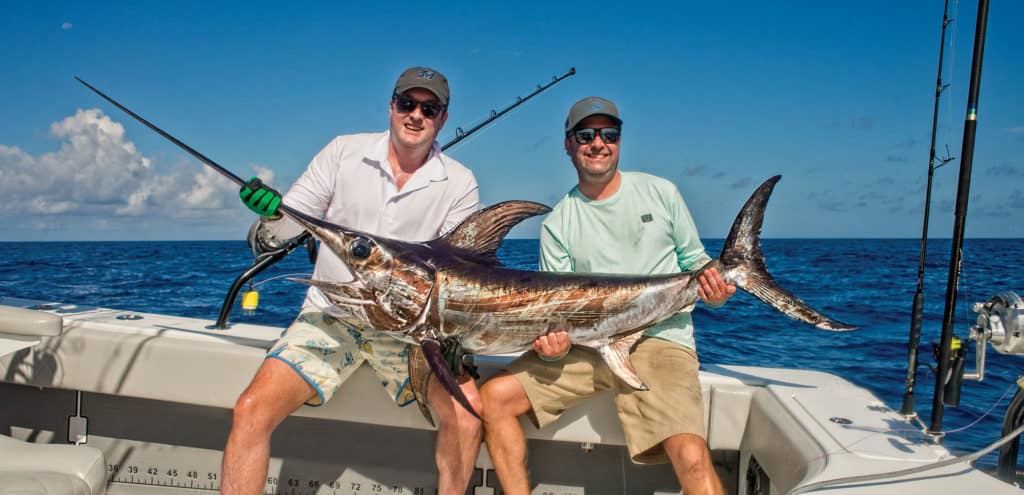
Business End
Braid in 80- to 100-pound-test is the preferred line for swordfish. Its sensitivity alerts anglers to the bite of a broadbill at great depths, especially when combined with a purpose-built rod, such as Seeker’s XXH daytime swordfish rod with an AFTCO No. 2 short curved butt. Rigging consists of a 200-pound-test, 75- to 150-foot wind-on mono top shot attached with a cat’s paw connection to a Bimini twist in the main line.
No Lights, No Bites
At the terminal end of the wind-on leader, Engel slides on four green LED strobes, spaced over about 8 feet, and secures them with rubber bands, then crimps the end of the top shot to one eye of a high-strength, ball-bearing swivel and crimps the leader to the other eye. He clips a larger Electralume disco strobe from Lindgren-Pitman to the same loop used to attach the sinker. The lights attract bait and squid, which then attract swordfish to the vicinity of the rigged bait.
Thanks to easy access to deep water and techniques honed from a range of sources, dreams of catching swordfish are coming true for an increasing number of SoCal anglers.
SWS Planner
What: Swordfish from 100 to 400 pounds
Where: Southern California canyons, ledges and seamounts
When: September to early January
Who: Anglers with reliable craft from 18 feet up. Looking for a charter? Here are three good choices:
Lucky B. Sportfishing
Capt. Brandon Nelson , 760-445-4834, luckybsportfishing.com
Pacific Bills Charters
Capt. Bill DePriest, 949-735-3271, pacificbillscharters.com
Seasons Sportfishing
Capt. Jaime Thinnes, 714-206-6146, seasonssportfishing.com
SWS Tackle Box
Rods: 5-foot XXH deep-drop rod rated for 80- to 130-pound-test with an AFTCO No. 2 short curved butt
Reels: Power-assist reel, such as Shimano BeastMaster 9000A, or traditional lever-drag, two-speed reel, like a Penn International 50 VISX
Line: 80- to 100-pound braid
Terminal Rig: Swordfish demand specialized terminal tackle. Until you are ready to take on the job yourself, the 200-pound, 150-foot Daytime Swordfish Leader by Three Buoys Fishing (threebuoysfishing.com; $45.50) incorporates a loop below the fluorescent-green wind-on section for attaching a 7- to 9-pound stick sinker with a longline clip. Electralume disco strobes are available from Lindgren-Pitman (lindgren-pitman.com; $39.95), and water-activated green-diamond LEDs are available from Promar (promar.com; $13.99).









